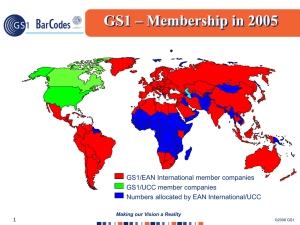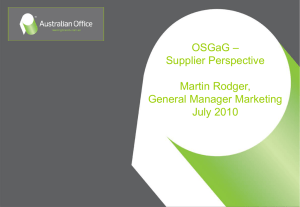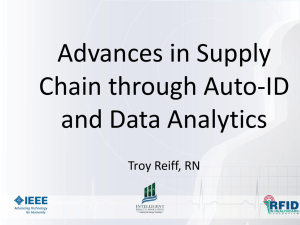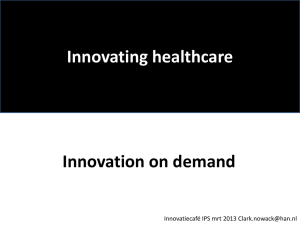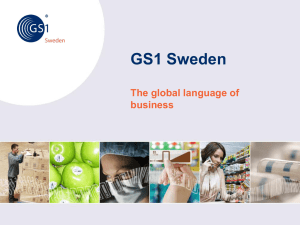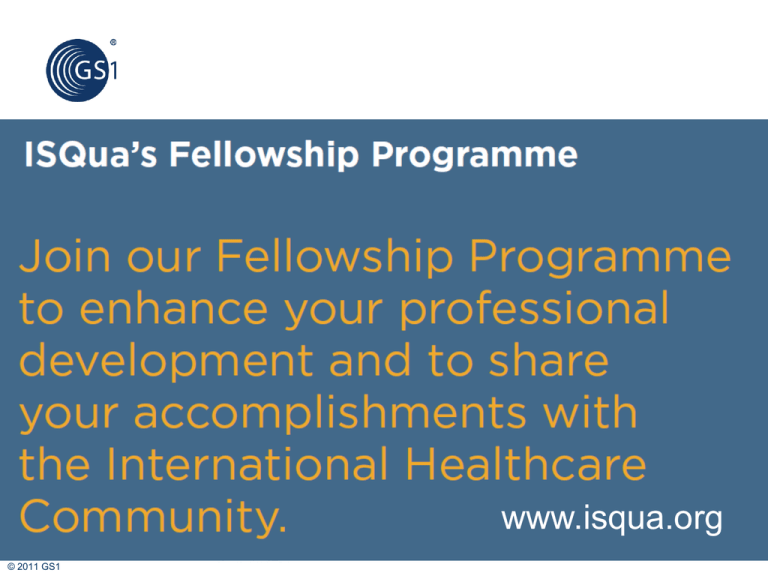
www.isqua.org
© 2011 GS1
GS1 Standards - Enabling the
Vision for
Traceability in Healthcare
ISQUA Webinar – 8th May 2013
Janice Kite, Traceability Director Healthcare
GS1 Global Office
Agenda
•
•
•
•
Who is GS1
Who is GS1 Healthcare
What we do
Development of GS1 standards for healthcare
(patients, products, places and transport) so far!
• Drivers of Traceability
• Emerging trends across the globe
© 2011 GS1
3
Who is GS1?
GS1
• a neutral, not-for-profit, international organisation
• dedicated to the design and implementation of global standards
• to improve the efficiency and visibility of supply chains globally and
across sectors
• GS1 Global Office (Brussels) and local offices in 111 countries
around the globe
© 2011 GS1
Global reach, local presence
Close to 2 million companies around the world use GS1
Across 150 countries
Over 6 billion transactions a day
© 2011 GS1
Global automatic identification
standards
GS1 Standards …
6 billion ‘beeps’ per day
Product identification in
Healthcare should be as
ubiquitous as it is in the retail
and grocery industries
© 2011 GS1
GS1 Healthcare – a voluntary, global
Healthcare User Group
To lead the healthcare sector to the successful
development and implementation of global standards
by bringing together experts in healthcare to enhance
patient safety and supply chain efficiencies.
© 2011 GS1
GS1 Healthcare User Group
Supply-side organisations engaging further
© 2011 GS1
Leading healthcare organisations pave
the way…
Buyer/Provider-side organisations going global
France
Austria
Ireland
© 2011 GS1
Germany
Saudi Arabia
Netherlands
Germany
Netherlands
Macedonia
USA
France
Hong Kong
Austria
USA
Switzerland
USA
USA
GS1 Healthcare around the World
Members global user group
Manufacturers
• 3M
• Abbott Laboratories/Abbvie
• Alcon Labs
• Amgen
• Astra Zeneca
• B. Braun
• Baxter
• Bayer
• Becton Dickenson
• Cook Medical
• Covidien
• Edwards Lifescience
• Fresenius
• GE Healthcare
• Genzyme
• GlaxoSmithKline
• Johnson & Johnson
• Medtronic
• Merck & Co.
• Pall Medical
• Pfizer
• Purdue Pharma
• Smiths Medical
• Takeda
• TEVA
• Zimmer
Solution provider
• Advanco
• Axway
• GHX
• Seidenader
• Excellis Health
• Tracelink
©•2011
GS1
Oracle
Distributors/Healthcare
providers/GPOs/T&L
• AmerisourceBergen (US)
• Cardinal Health (US)
• CH Aulnay sous Bois (France)
• Comparatio Health (Germany)
• DHL Exel Supply Chain (UK)
• Erasmus MC Rotterdam (NL)
• Filip Vtori (Macedonia)
• Hong Kong Hospital Authorities
• King FAISAL Specialist Hospital &
Research Center (Saudi Arabia)
• McKesson (US)
• Novation (US)
• Orthopädisches Spital Speising Wien
(Austria)
• Premier (US)
• St. James Hospital (Ireland)
• Marienhospital Herne (Germany)
• UMC Groningen (NL)
• UNI.HA (representing 17 French
university hospitals)
• University Kentucky Healthcare (US)
• Wiener Krankenanstaltenverbund
(Austria)
Non-voting members
• AHRMM
Cladimed
• EDQM – Council of Europe
• FDA USA
• Instituto Brasileiro de Ética
Concorrencial – ETCO
• Public Health Agency of Canada
• US DoD
Local participation
Manufacturers
• 3M
• Bayer
• Becton Dickinson
• Boehringer Ingelheim
• Coloplast
• Draeger Medical
• Genzyme
• Hospira
• Kimberly-Clark
• Novo Nordisk
• Purdue Pharma
• St. Jude Medical
• Stryker
• Teva Pharmaceuticals
• Terumo
• UCB
• Upsher-Smith
Distributors/Wholesalers
• Aexxdis
• Amerinet
• AmerisourceBergen
• CH2
• Depolabo
• Galexis
• GAMMA Wholesale
• Geodis
• McMahon
• Owens & Minor
Healthcare providers/Retailers
• Alfred Hospital (Australia)
• Ascension Health (US)
• Capital District Health (Canada)
• CHU de Québec (Canada)
• CHU Dijon (France)
• HUG Geneva (Switzerland)
• London Drugs (UK)
• Mayo Clinic (US)
• Sisters of Mercy (US)
• Sobeys Pharmacy (UK)
• UHCS Augusta VA (US)
• Walgreens (US)
• Walmart (US)
Associations
• AHA (US)
• CIP/ACL (France)
• CHeS (US)
• EFPIA (Europe)
• Eucomed (Europe)
• FENIN (Spain)
• GIRP (Europe)
• HDMA (US)
• International Hospital Federation
• JFMDA (Japan)
• Medical Industry Association of
Australia
• NACDS (US)
• Patient Safety Foundation (US)
… And many more …
Recognised, open and neutral
source
© 2011 GS1
And many more…
GS1 and Joint Initiative Council (JIC) in
Healthcare
International European Committee
Organisation for for Standardization
Standardization
World Health
Organization
© 2011 GS1
Health Level 7
international
International
World Customs
Society for Blood
Organization
Transfusion
International
Clinical Data
Health
Interchange Standards
Terminology SDO
Consortium
European
Association of
Hospital
Pharmacists
Integrating the
Healthcare
Enterprise
European
International Society
Association of
for Quality in
Medical Device
Healthcare
manufacturer
GS1 in Healthcare: global system of
standards
© 2011 GS1
13
GS1 in Healthcare: global system of
standards
Track
T
R
A
C
E
A
B
I
L
I
T
Y
Trace
Authentication
Pedigree
Returns
Recalls
© 2011 GS1
14
Lack of standards in daily life is
inefficient and annoying…
© 2011 GS1
15
Lack of standards in Healthcare is
inefficient and adds risk…
• Multiple bar codes on one
package – which one to scan?
• Different types of bar codes –
inconsistency; incompatibility
• No bar code – need to bar code;
re-package; re-label
© 2011 GS1
16
The Need for Global standards in
Healthcare
Diverging country requirements
Manufacturing headache
Additional cost and risk
© 2011 GS1
Reduce complexity
Speak
one
language
© 2011 GS1
GS1 Standards for
Healthcare
Global work groups
AIDC Application Standards
Global Data Synchronisation & Product
Classification
Traceability in Healthcare
Public Policy
Healthcare Provider Advisory Council*
Meet bi-weekly via conference calls
* HPAC Monthly
© 2011 GS1
GS1 Standards for Healthcare
Standards development continues, but global
standards are ALREADY available to build on:
AIDC Application Standards for 90% of medical
products
AIDC Application Standards for small instruments
Healthcare extension in next GDSN release
Global Traceability Standard for Healthcare
GTIN Allocation Rules for Healthcare
Guideline for plasma derivatives
Patient and Caregiver Identification
AI for National Healthcare Reimbursement
Number (NHRN)
© 2011 GS1
GS1 Standards - Enabling the
Vision for Traceability in
Healthcare
Traceability in Healthcare I (TH-I)
DELIVERED:
Global Traceability Standard for Healthcare
(GTSH)
PUBLISHED 27th February 2009
http://www.gs1.org/docs/gsmp/traceability/Global_Traceability_Standard_Healthcare.
pdf
GTSH Implementation Guideline
PUBLISHED 24th April 2009
http://www.gs1.org/docs/gsmp/traceability/Global_Traceability_Implementation
_Healthcare.pdf
©
Copyright
© 2011
GS1 GS1 AISBL, 2012. All Rights Reserved.
23
Key Drivers for traceability
Regulations emerge worldwide
Supply Chain costs increase
Electronic Health Records
Medication errors
Counterfeiting
Brand Protection
© 2011 GS1
24
GS1 Members Vision for Traceability in Healthcare
•
Full, End to End, actionable visibility of finished pharmaceuticals 1and
medical devices in healthcare globally, from
Point of Production to
2
Point of Use
•
All authentic items are identified with the appropriate GS1 Identification Keys (e.g. GTIN)
and appropriate Application Identifier (AI, e.g. Serial No. AI(21)), if applicable, at point of
production
Supply chain identifiers are associated with the patient and remain with/on items throughout
their intended useful life
All physical locations are identified with the appropriate GS1 Identification Key (e.g. GLN)
across the entire supply chain
All patients and care givers, when in a care giving environment, are identified with the
appropriate GS1 identification Keys (e.g. AI 8017; AI 8018)
Agreed master data is captured and shared (e.g. via GDSN) amongst trading partners
Agreed transactional data is captured and shared (e.g. via business-to-business messaging)
amongst trading partners
Agreed event data is captured and shared (e.g. via EPCIS) amongst trusted traceability
stakeholders, based on data sharing/security policies
• SO THAT:
•
•
•
•
•
•
1. The terms production or producer can also mean commercially available, manufacture(r), creation(or), compounding(er)…
2. The terms use or used can also mean consumed, infused, implanted, destroyed
© 2011 GS1
25
GS1 Members Vision for Traceability in Healthcare
• Full, End to End, actionable visibility of finished pharmaceuticals
and medical devices in healthcare globally, from Point of
Production1 to Point of Use2
•
•
•
•
•
•
•
SO THAT:
Items can be tracked (forward / downstream) across the entire supply chain
(production to use) in real time
Items can be traced (backward / upstream) across the entire supply chain
(from current location back to the producer) in real time
Item identification is available for use at patient bedside to ensure the Patient
Rights3 are achievable
Patients Electronic Health Records (EHRs) are updated with agreed
traceability information, including Care Giver identification
Counterfeit products are detected when entering the legitimate supply chain
A product recall would be fast, efficient and effective
1. The terms production or producer can also mean commercially available, manufacture(r), creation(or), compounding(er)…
2. The terms use or used can also mean consumed, infused, implanted, destroyed
3. Pharmaceuticals (5): Right patient, right drug, right dose, right route, right time. Medical Devices (8): right device, right location, right time, right
condition, right procedure, right anatomic site, right patient, right user
© 2011 GS1
26
GTSH “One up, One down”
Flow of Info
Flow of Info
Flow of goods
Flow of goods
Flow of Info
Information
Flow
Physical
Flow
Traceability
Partner
© 2011 GS1
Traceability
Partner
Flow of goods
Traceability
Partner
Traceability
Partner
Pharma – Different emerging models… US
Driver: To address counterfeiting: many actors in the supply chain,
legitimate/illegalblurred (background? Read: Dangerous Doses,
Katherine Eban (2005, ISBN 0-15-603085-3))
• Numerous US States have enacted laws, e.g. Nevada, Florida
• California most ‘notorious’ because it specifies an ePedigree Model (aka:
Chain of Custody/Chain of Ownership)
• Desire to identify and prosecute perpetrators
• Enforcement date continuously pushed out, currently starts 2015
© 2011 GS1
28
Pharma – Different emerging models…
Turkey
Driver: Reimbursement Fraud; pharmacists claiming more than once for
dispensed product
• Government developed and controlled, Centralised Track & Trace system (iTS)
• Enforcement date 2010, live 2+ years (the only live system globally!)
• Phase 1: Manufacturers published data to MoH central database (2010)
• Phase 2: Distributors (2012)
• Future phases: ePrescriptions, Patient access
• ROI in ONE YEAR!
• Reimbursement fraud eliminated
• Examples of counterfeits being
detected entering legitimate
supply chain
• Prosecutions…
…Argentina
© 2011 GS1
29
Pharma – Different emerging models…Europe (1)
Driver: To address counterfeiting (falsified medicines), prevent them
reaching the patient
Two emerging (competing?) models: EDQM & EFPIA:
• European Directorate for the Quality of Medicines & HealthCare (EDQM) eTACT
• Part of the Council of Europe; EDQM members 37 European countries, bigger
than EU
• Traceability from manufacture to the patient, ultimately given also patients
access to authenticate product
• Developed by EDQM
© 2011 GS1
30
Pharma – Different emerging models…Europe (2)
Driver: To address counterfeiting (falsified medicines), prevent them
reaching the patient
•
EFPIA /GIRP/PGEU/ EAEPC European Stakeholder Model (ESM)
• A pan-European end-to-end system enabling medicines to be verified at point of
dispensing
• Developed by the stakeholders who will use it on a day-to-day basis
• Run on a non-profit basis; Costs to be borne by Manufacturing Authorisation Holders
• Effective system expected in 2017
Pharmaceutical
Manufacturer
Wholesaler
Wholesaler
Pharmacist
Patient
Product
Flow
Unique Serialisation
with Random Numbers
Verification upon
Dispense to Patient
Voluntary
Verification
2D Data Matrix Code
on 2nd Pack
Upload Number
© 2011 GS1
Product
#
Batch
Expiry
S/N
Medicines
Verification
Repository
Authenticate Number
31
Global standards enable…
Compliance with regulations,
effective and efficient implementation of traceability
systems in Healthcare
Such as:
Track & Trace, Authentication, UDI
= Visibility*
*Visibility = What, When, Where & Why
© 2011 GS1
New McKinsey & Company report
quantifies supply chain issues in
Healthcare
New McKinsey report “Strength in unity: The
promise of global standards in healthcare”
Highlights the cost savings and patient safety
benefits of adopting a single global supply
chain standard in healthcare
Source: http://www.mckinsey.com
© 2011 GS1
Available at:
http://www.gs1.org/healthcare/mckinsey or
http://www.gs1.org/docs/healthcare/McKinsey_Healthcare_R
eport_Strength_in_Unity.pdf
33
Huge cost savings and patient safety benefits
when adopting a single global standard in
healthcare
•“Implementing global standards across the entire healthcare
supply chain could save 22,000-43,000 lives and avert 0.7
million to 1.4 million patient disabilities”
•“Rolling out such standards-based systems globally could
prevent tens of millions of dollars’ worth of counterfeit
drugs from entering the legitimate supply chain”
•[We] “estimate that healthcare cost could be reduced by $40
billion-$100 billion globally” from the implementation of global
standards
•“Adopting a single set of global standards will cost
significantly less than two” (between 10-25% less cost to
stakeholders)
SOURCE: McKinsey report, “Strength in unity: The promise of global standards in healthcare”, October 2012
© 2011 GS1
34
Ultimately, it’s all about…
PATIENT SAFETY!
Global standards enable patient safety worldwide !
© 2011 GS1
35
Contact Details
Janice Kite
Traceability Director Healthcare
GS1 Global Office Brussels
E janice.kite@gs1.org
W www.gs1.org/healthcare

